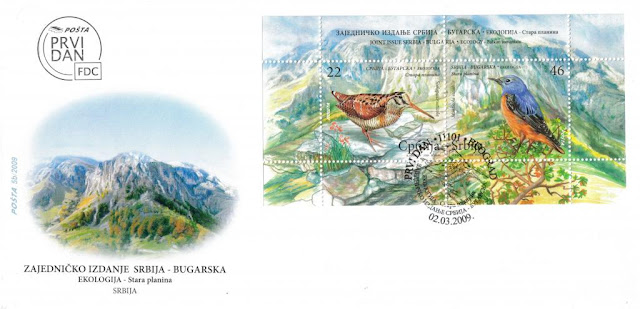Anyways, I am happy to have this opportunity to present this joint issue between Serbia and Bulgaria...I really wonder why WE don't have such awesome joint issues...or why we BARELY have any joint issues in the first place?! The joint issues mean closer cooperation between the postal administrations and exchange o valuable experiences in the field of postal circulation. On this occasion, Serbia and Bulgaria have chosen to portray the Balkan Mountain (or Stara Planina as known in Serbia and Macedonia for example) which belongs to the big Balkan mountain range that runs 530km from the Black Sea, on the East, to the Vrška Čuka Peak on the West and is part of the Carpathian-Balkan Mountain range. The smaller, western part of the mountain is located on the territory of East Serbia. Its highest peak is Botev (2376m) in Bulgaria, while on the Serbian side, the highest peak is Midžor (2169m).
The area of the Balkan Mountain was declared a National Park back in 1997 and is also classified as an area of interstate (Green Belt Programme) and international (Important Birds Areas, Important Plants Areas, Prime Butterfly Areas) etc
The ornithofauna of the Balkan Mountain is very rich and until nowadays (speaking about 2009 here), has 206 recorded bird species, of which 104 are protected by the Bern Convention and the Regulation of the Serbian Government on Natural rarities protection)
The motif of these jointly issued stamps is the Balkan mountains landscape with birds: Scolopax rusticola (Eurasian Woodcock) and Monticola saxatilis (Rufous - tailed Rock-thrush)
The Eurasian Woodcock is 33-38 cm in length, including a 6-8cm long bill. Its eyes are located high on the sides of its head, giving it a 360° monocular vision. Eurasian woodcocks nest on the ground, in low cover in woodland. It feeds by probing in the ground for invertebrates with its long bill. This species has a global population of an estimated 15-16 million birds.
The Rufous - tailed Rock-thrush is a songbird which is regularly seen on the Balkan Mountain. It is a medium sized bird of 17-20 cm in length. This species breeds in open dry hilly areas, usually 1500m above the sea level. In Serbia, its population is estimated to be between 1400 and 2000 individuals, and according to this fact, is considered as a declining species in the country.
And here you have the s/s on the other FDC...it is just awesome, don't you think?
for more birdy stuff today, click on the link below...and have a great Sunday!!






